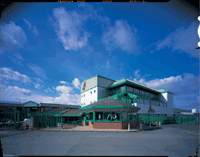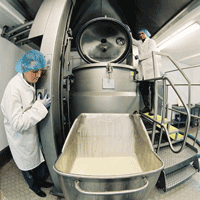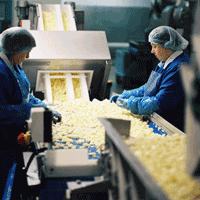| INFORMATION: Free information is available from PREACTOR on the subject in this story. Click here to request a copy |
 Hitchen Foods, based in Wigan, supplies a comprehensive range of added value vegetables and salad based products to the major multiple retailers and food service sector.
Hitchen Foods, based in Wigan, supplies a comprehensive range of added value vegetables and salad based products to the major multiple retailers and food service sector.
First established in 1945, Hitchen Foods now prepares over 100,000 meals a day, created to exacting recipes developed by the companys own top chefs. Its 750-strong team combine to produce and despatch quality fresh products on the same day, which can be available in-store for the consumer the following morning. The company works closely alongside a range of reputable growers to ensure all foodstuffs are of the highest quality. In order to continually improve its performance as a leading food supplier, and in order to enhance further the companys mantra of quality, freshness and speed, it decided to source a state-of-the-art advanced planning and scheduling software solution. From this point on, Hitchen Foods highly beneficial relationship with software solutions provider Preactor International was established.
Constraints
 Hitchen Foods production facilities comprise four main business units. Unit 1 processes all the bulk ingredients such as onion, carrot or potato for insertion into ready meals. This Unit also supplies bulk ingredients to the other business units. Unit 2 handles salads. Unit 3 processes mashed products and Unit 4 prepares products such as jacket potatoes. The units can often be, unsurprisingly, highly dependent on one another, said Darren Spanswick, Hitchen Foods planning manager. Spanswick provided some background regarding the companys production scheduling method prior to sourcing Preactor APS: We would receive an order from a customer and then key the data into Excel spreadsheets. However, there was never any regular forum where each unit could come together and determine what the priorities should be overall. In a nutshell, there was precious little communication from one department to the next. As is human nature to a large extent, each unit would tend to prioritise its own work before considering the needs of the other units. So the main problem was lack of overall production visibility.
Hitchen Foods production facilities comprise four main business units. Unit 1 processes all the bulk ingredients such as onion, carrot or potato for insertion into ready meals. This Unit also supplies bulk ingredients to the other business units. Unit 2 handles salads. Unit 3 processes mashed products and Unit 4 prepares products such as jacket potatoes. The units can often be, unsurprisingly, highly dependent on one another, said Darren Spanswick, Hitchen Foods planning manager. Spanswick provided some background regarding the companys production scheduling method prior to sourcing Preactor APS: We would receive an order from a customer and then key the data into Excel spreadsheets. However, there was never any regular forum where each unit could come together and determine what the priorities should be overall. In a nutshell, there was precious little communication from one department to the next. As is human nature to a large extent, each unit would tend to prioritise its own work before considering the needs of the other units. So the main problem was lack of overall production visibility.
Sourcing the solution
When working for another company, Spanswick and colleague Steve Smith, Hitchen Foods supply chain manager, had been familiar with the capabilities of Preactor APS. Hitchen Foods board of directors was also convinced that the software would be the best system for the companys needs. The path was clear for sourcing Preactor, which took place in late 2003. We wrote our required specifications for the system internally, said Smith. This was then passed on to Preactor and its personnel wrote this into the system for us, sending us various test files from time to time to ensure the software worked satisfactorily. Although we ran somewhat over budget due to bespoke reports and additional support costs due to customised coding, the subsequent benefits of the system have made the additional outlay well worth it.
Go live
 Because we had such a variety of products and a number of separate business units, we decided to implement Preactor APS in two main phases, said Spanswick. At Phase 1 of the implementation, the system went live in stages at each unit over a six-month period. Each unit was fully utilising the system at Phase 1 stage by mid-2004. Phase 1 was dedicated to finished products and the packing lines, and since go-live the company has relied on a master viewer in its planning office to take the orders and make the decisions as to what the production plan should be for that week. Once it has been explained to and agreed with each units production manager the plan is issued to each unit, and shop floor staff have access to the plan via a viewer at the end of each packing line. Then each production manager reports back through their viewer regarding the units performance. So what weve done is take the decision making away from separate areas and focus it at one point, i.e. the planning office, said Spanswick.
Because we had such a variety of products and a number of separate business units, we decided to implement Preactor APS in two main phases, said Spanswick. At Phase 1 of the implementation, the system went live in stages at each unit over a six-month period. Each unit was fully utilising the system at Phase 1 stage by mid-2004. Phase 1 was dedicated to finished products and the packing lines, and since go-live the company has relied on a master viewer in its planning office to take the orders and make the decisions as to what the production plan should be for that week. Once it has been explained to and agreed with each units production manager the plan is issued to each unit, and shop floor staff have access to the plan via a viewer at the end of each packing line. Then each production manager reports back through their viewer regarding the units performance. So what weve done is take the decision making away from separate areas and focus it at one point, i.e. the planning office, said Spanswick.
Phase 2 in progress
Hitchen Foods is currently in the stages of preparing for go-live with Phase 2, which will concentrate on its preparation processes, washing lines and cooking facilities. Currently the company doesnt hold any Bill of Material (BoM) information on its ERP system, so BoM data cannot be fed into Preactor APS prior to putting together a weekly schedule. Therefore, another big part of Phase 2 will be to get Hitchen Foods ERP software up to speed with BoM information and ensure that it can be seamlessly transferred to Preactor APS. Spanswick said: Preactor will then be perfectly geared to provide us with all the planning and scheduling information we need concerning prep, washing and cooking, and keeping to specification and lead time, in addition to the benefits it is already providing us with at Phase 1 regarding finished goods and packing.
Benefits
Even though Hitchen Foods is yet to complete Phase 2, it is already benefiting from having much better visibility particularly with regard to planning issues. The benefits so far have been more in terms of planning than production, said Spanswick. The planning office can now see at any time in the day where the packing lines are up to and plan any changes accordingly. The benefits for production will kick in with phase 2 when reports will be generated by the system for product and line efficiency and consumption reports with work-in-progress netted off. All of this means that production will no longer need to fill this information into paperwork on the lines and then key the information in again into their own spreadsheets.
At Phase 1 Preactor APS is also highly beneficial during the companys daily 3.30 pm production and planning meetings, as Smith said: Each production manager can update the other units as to where his team stands with regard to current jobs, any problems that might have occurred and possible ways of getting round them etc. Preactor APS helps us to have greater overall visibility and knowledge in terms of our everyday shop floor processes. Our daily meetings are also useful for ongoing discussions regarding our development of Phase 2, which is anticipated to go live around May 2006. Also, efficiency reports and information concerning any downtime that might have been suffered are already being stored in Preactor APS. This is very useful information to have at your fingertips when preparing reports.
 Spanswick summed up the benefits Hitchen Foods has benefited from so far since going live with phase 1: Preactor APS has already become an integral part of our business, particularly from a planning point of view. And once Phase 2 comes on stream next year, we will have in place a software system that will bring us major benefits in terms of production efficiency, seamless visibility of data and overall cost and time effectiveness.
Spanswick summed up the benefits Hitchen Foods has benefited from so far since going live with phase 1: Preactor APS has already become an integral part of our business, particularly from a planning point of view. And once Phase 2 comes on stream next year, we will have in place a software system that will bring us major benefits in terms of production efficiency, seamless visibility of data and overall cost and time effectiveness.
Mike Novels, Preactor Internationals managing director, said of the project: The fresh foods business has a wide range of problems not always apparent in other sectors. Sudden changes in demand, sudden changes in material quality and amount available makes planning a bit of a nightmare, so anything that can help management become more agile in this environment is bound to help their bottom line as well as customer service.
| INFORMATION: Free information is available from PREACTOR on the subject in this story. Click here to request a copy |

Add a Comment
No messages on this article yet